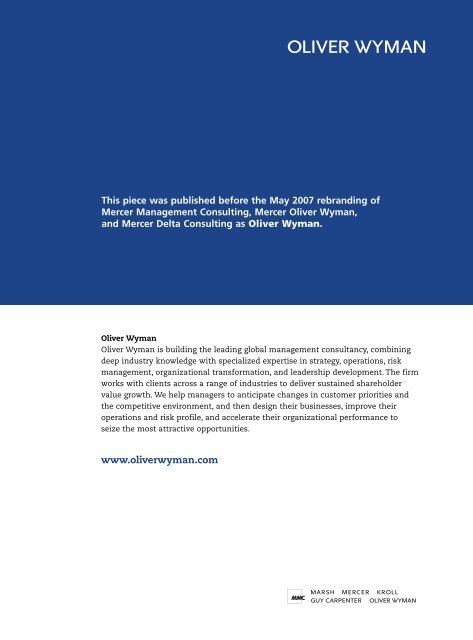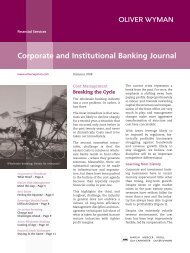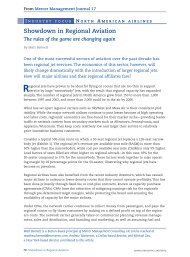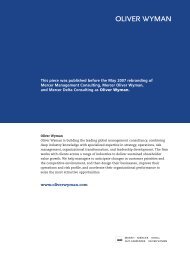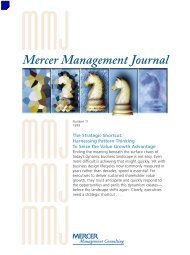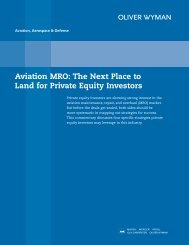Download the Report - Oliver Wyman
Download the Report - Oliver Wyman
Download the Report - Oliver Wyman
Create successful ePaper yourself
Turn your PDF publications into a flip-book with our unique Google optimized e-Paper software.
This piece was published before <strong>the</strong> May 2007 rebranding of<br />
Mercer Management Consulting, Mercer <strong>Oliver</strong> <strong>Wyman</strong>,<br />
and Mercer Delta Consulting as <strong>Oliver</strong> <strong>Wyman</strong>.<br />
<strong>Oliver</strong> <strong>Wyman</strong><br />
<strong>Oliver</strong> <strong>Wyman</strong> is building <strong>the</strong> leading global management consultancy, combining<br />
deep industry knowledge with specialized expertise in strategy, operations, risk<br />
management, organizational transformation, and leadership development. The firm<br />
works with clients across a range of industries to deliver sustained shareholder<br />
value growth. We help managers to anticipate changes in customer priorities and<br />
<strong>the</strong> competitive environment, and <strong>the</strong>n design <strong>the</strong>ir businesses, improve <strong>the</strong>ir<br />
operations and risk profile, and accelerate <strong>the</strong>ir organizational performance to<br />
seize <strong>the</strong> most attractive opportunities.<br />
www.oliverwyman.com
Mapping value growth in complex portfolios<br />
If you have lots of businesses, how do you unlock<br />
<strong>the</strong>ir latent value?<br />
By Richard Balaban, Phyllis Rothschild, and Bill Stevenson<br />
Running a large, multi-business company has never been harder than it is today. For one thing,<br />
investors tend to accord higher multiples to “pure play” firms, in part because <strong>the</strong>y understand<br />
what <strong>the</strong>y’re buying. One recent academic study, for example, finds that <strong>the</strong> shares of highly diversified<br />
firms traded, on average, for almost 10 percent less than those of focused firms during <strong>the</strong><br />
1980s and early 1990s. 1<br />
Multi-business firms also must contend with multiple challenges caused by repeated economic,<br />
social, and technological changes in <strong>the</strong>ir various markets. These changes frequently lead to<br />
shifts in who owns <strong>the</strong> profit zone in an industry, with value moving rapidly away from traditional<br />
players. With this kind of pressure applied simultaneously across multiple businesses in<br />
a complex portfolio, keeping track of risks and growth opportunities can seem overwhelming.<br />
The problem is compounded by <strong>the</strong> fact that, over <strong>the</strong> past decade, <strong>the</strong> surest route to growth<br />
in many industries has been through acquisitions. Merger mania has created new behemoths:<br />
More than fifty public companies currently employ more than 100,000 workers; in <strong>the</strong> mid-<br />
1980s, only eighteen did.<br />
Firms bent on consolidation in one industry often pick up new products or services through<br />
<strong>the</strong>ir acquisitions, as Nortel Networks and Kimberly-Clark have found. As a result, <strong>the</strong> typical<br />
CEO who might have had four or five businesses to manage ten years ago has twenty or more<br />
businesses today. Even many firms considered “pure plays” actually sell to multiple customer<br />
sets in multiple geographies, with multiple combinations of products and services. Each of<br />
<strong>the</strong>se segments can have very different growth dynamics.<br />
The challenge for senior managers running a multi-unit company is twofold:<br />
TOptimizing <strong>the</strong> businesses you already have and want to keep.<br />
TIdentifying and building <strong>the</strong> best new businesses for <strong>the</strong> future,<br />
sooner than your competitors.<br />
Some firms manage to surmount <strong>the</strong>se problems by finding a jewel in <strong>the</strong>ir portfolio and<br />
diverting resources toward growing that fledgling business. In <strong>the</strong> mid-1980s, for example,<br />
fiber optics was a tiny portion of Corning’s portfolio. Today, it represents a dominant and<br />
growing part of Corning’s business and value. Corning made <strong>the</strong> right bets to adapt its<br />
technology to a new, rapidly expanding market.<br />
Richard Balaban, Phyllis Rothschild, and Bill Stevenson are vice presidents of Mercer Management<br />
Consulting. Balaban is based in London, and Rothschild and Stevenson are based in Boston.<br />
1 Raghuram Rajan, Henri Servaes, and Luigi Zingales, “The Cost of Diversity: The Diversification Discount and Inefficient<br />
Investment,” National Bureau of Economic Research Working Paper No. 6368, 1998.<br />
Mercer Management Journal Portfolio redesign 1
Similarly, in 1992, Nokia was a conglomerate producing everything from steel cable to diapers.<br />
The newly installed CEO, Jorma Ollila, bet <strong>the</strong> company on one of its smaller products, cell<br />
phones, launching Nokia on a period of unprecedented growth.<br />
But not every company can find one business that grows so fast as to outweigh all <strong>the</strong> o<strong>the</strong>r<br />
missteps in <strong>the</strong> portfolio. And it’s often difficult to sort out <strong>the</strong> right mix of business improvement<br />
and business reinvention. The complexity of <strong>the</strong> strategist’s dilemma can be sensed by<br />
imagining <strong>the</strong> thoughts of a newly installed CEO at a large technology-based company.<br />
“The company I’m running is really dozens of companies. We make packaging materials,<br />
electrical components, adhesive tape, auto parts, specialty chemicals, machine tools, and<br />
calibrating equipment. We sell to OEMs, corporate clients, wholesalers, and consumer<br />
retailers. We earn profits based on product offerings, distribution channels, financing<br />
plans, value-added services, and information management.<br />
I’m getting business plans from my unit managers with customer segmentation, competitive<br />
intelligence, and investment proposals that all pay out. But I don’t know which to<br />
back. And I don’t know whe<strong>the</strong>r <strong>the</strong>re’s a whole set of o<strong>the</strong>r options that haven’t been<br />
put on <strong>the</strong> table. How do I make sense of it all?”<br />
In such firms, executives setting strategy and allocating finite resources are often overwhelmed<br />
by inconsistent information from <strong>the</strong> business units. The only common tools across units may be<br />
backward-looking financial metrics, which offer little help in choosing among hundreds of investment<br />
options presented in business reviews.<br />
Moreover, when management cannot clearly articulate <strong>the</strong> strategy of how <strong>the</strong> pieces<br />
fit toge<strong>the</strong>r, it’s no wonder that investors find large companies opaque. Analysts can understand<br />
<strong>the</strong> risks in <strong>the</strong> historic drivers of profit far more easily than <strong>the</strong>y can identify <strong>the</strong> future sources of<br />
growth. As a result, shareholder value growth tends to be low relative to more focused firms. For a<br />
large, complex company, investors need a clear understanding of <strong>the</strong> competitive position and a<br />
well-defined vision of <strong>the</strong> next moves.<br />
So how can a CEO lead <strong>the</strong> organization to consistent growth performance across a diverse<br />
portfolio? How can a firm turn its participation in multiple markets with multiple business<br />
designs into a source of advantage? Senior managers in this situation must be able to answer<br />
several hard questions:<br />
TWhere is <strong>the</strong> true value of <strong>the</strong> current portfolio, and where will it be three and five years out?<br />
TWhat are <strong>the</strong> real risks to that value?<br />
TWhat are <strong>the</strong> threats in each unit’s economic neighborhood, both from close<br />
competitors and from firms on <strong>the</strong> periphery of <strong>the</strong> radar screen?<br />
TWho are <strong>the</strong> portfolio’s leading customers and how are <strong>the</strong>ir priorities shifting?<br />
TWhich businesses need to be redesigned to maintain or create growth?<br />
TWhat new opportunities, or “white spaces,” are available, and which deserve<br />
<strong>the</strong> firm’s backing?<br />
THow is <strong>the</strong> firm taking advantage of <strong>the</strong> broad range of products and customers in its portfolio?<br />
2 Portfolio redesign Mercer Management Journal
Answering those questions, and <strong>the</strong>n putting <strong>the</strong> information to good use, requires an innovative<br />
yet disciplined approach to corporate portfolio strategy. The senior management team must systematically<br />
drive value growth through a wide range of diverse operations, recognizing <strong>the</strong> broadscale<br />
opportunities and risks without losing sight of <strong>the</strong> crucial differences among businesses.<br />
This emerging discipline for driving portfolio growth departs from traditional portfolio thinking.<br />
Flaws in <strong>the</strong> traditional tools<br />
The traditional approach to portfolio management has typically emphasized a role for <strong>the</strong> corporate<br />
center in active financial management or in driving operational excellence through corporate-run<br />
processes.<br />
At <strong>the</strong> extreme, financial management assumes <strong>the</strong> role of a holding company, involving a highly<br />
decentralized, non-interventionist style of management. The CEO and <strong>the</strong> senior management<br />
team take on <strong>the</strong> role of investors, buying and selling businesses based on <strong>the</strong>ir financial attractiveness<br />
using traditional investment ratios and metrics: ROI, revenue and margin growth, and<br />
so on. The operational excellence approach, by contrast, emphasizes improving divisional profit<br />
margins through quality programs, centralized services, reduction in overhead costs, and unified<br />
controls over budgeting, cash flow, and capital management.<br />
Both approaches offer benefits, to be sure. Instituting across-<strong>the</strong>-board financial controls<br />
is often a necessary step, one that may yield a harvest of low-hanging fruit in <strong>the</strong> form of<br />
enhanced efficiencies, process simplification, and staff reductions. Margins are likely to improve.<br />
However, our experience indicates that financial information typically provides a weak platform<br />
from which to map growth opportunities. Corporations developed on this basis tend to build a<br />
portfolio of high-share, high-volume growth businesses that are unrelated to one ano<strong>the</strong>r. The<br />
result is a collection of business unit “silos” that do little to share <strong>the</strong>ir combined reach and customer<br />
knowledge. The basic leadership message is, “Give me 15 percent growth. I don’t care how<br />
you do it.”<br />
The operational excellence model, for its part, can achieve incremental gains. But once those<br />
improvements are exhausted, this approach fails to provide a platform for future growth.<br />
Both of <strong>the</strong>se approaches, moreover, tend to be backward-looking, focusing on past financial<br />
performance ra<strong>the</strong>r than present and future customer and marketplace dynamics. They tend<br />
to direct your thinking inward, on what you do best, on <strong>the</strong> products you make, on reducing your<br />
costs, or building synergies across <strong>the</strong> businesses you already have. This inside-out perspective is<br />
ill-suited to help identify changing patterns of strategic risk, such as when business models are<br />
in danger of becoming obsolete. They also fail to identify <strong>the</strong> white spaces of opportunity. And by<br />
restricting <strong>the</strong> discussion to financial performance, <strong>the</strong>y leave <strong>the</strong> CEO and senior management<br />
team without a vocabulary to articulate <strong>the</strong> common <strong>the</strong>mes that unite <strong>the</strong> company’s many<br />
operations, making it very difficult to formulate and communicate a forward-looking strategic<br />
message about adaptation and growth.<br />
To effectively manage strategic risk and define growth opportunities in rapidly changing markets,<br />
today’s executives need a more powerful, indeed strategic approach, with tools capable of sensing<br />
new shifts in <strong>the</strong> competitive landscape and anticipating where <strong>the</strong> next profit zones will be.<br />
Mercer Management Journal Portfolio redesign 3
Becoming business design architects<br />
A far more effective approach is for <strong>the</strong> CEO and <strong>the</strong> strategic team to become business design<br />
architects. In this role, <strong>the</strong> team focuses on understanding <strong>the</strong> evolving priorities of its best customers,<br />
both current and potential, and <strong>the</strong> new business designs that promise to capture <strong>the</strong><br />
profit zones in each of <strong>the</strong> firm’s markets. By anticipating changes in <strong>the</strong> landscape, minimizing<br />
<strong>the</strong> risks and taking maximum advantage of <strong>the</strong> opportunities, <strong>the</strong> business design architect is in<br />
a better position than competitors to seize and hold <strong>the</strong> high ground.<br />
By business design, we mean <strong>the</strong> discipline of making choices along several closely interrelated<br />
strategic dimensions: customer selection, <strong>the</strong> unique value propositions for those customers, <strong>the</strong> profit<br />
model, <strong>the</strong> scope of activities, <strong>the</strong> points of strategic control over profit streams, and <strong>the</strong> organizational<br />
architecture required. Great companies are characterized by insightful, mutually reinforcing responses<br />
in all six areas.<br />
Companies managed by business design architects, who continuously enhance and evolve <strong>the</strong>ir<br />
business designs, have outperformed those that have employed traditional financial management<br />
tools. Williams Companies, for example, has moved from a focus on natural gas transmission to<br />
building new business designs in broadband using <strong>the</strong> firm’s primary point of strategic control,<br />
rights-of-way through populated areas. LVMH moved from building a portfolio of luxury brands to<br />
going downstream into distribution channels as a way to better control <strong>the</strong> customer interface.<br />
The stunning achievements of General Electric become more accessible when viewed through<br />
<strong>the</strong> lens of business design. At first glance, GE seems like a loosely connected collection of businesses<br />
ranging from aircraft engines, plastics, and appliances to finance, dynamos, and broadcasting.<br />
Many of GE’s units, however, share a common “customer solution” business design. Over<br />
<strong>the</strong> past fifteen years, <strong>the</strong>y have steadily broadened <strong>the</strong>ir value propositions from simply selling<br />
a product to financing <strong>the</strong> sale, providing maintenance and o<strong>the</strong>r downstream support services,<br />
and even guaranteeing equipment operations and uptime. GE is now rapidly moving to a set of<br />
new e-commerce offerings built around <strong>the</strong> customer’s activity chain in using a product.<br />
Exhibit 1 Becoming a business design architect<br />
Driving growth typically requires new business designs, not just improving<br />
current designs.<br />
Percent of<br />
market<br />
capitalization<br />
200<br />
180<br />
160<br />
140<br />
120<br />
100<br />
80<br />
60<br />
40<br />
20<br />
0<br />
Future market capitalization (illustrative)<br />
10<br />
100<br />
Current<br />
portfolio<br />
Value-destroying<br />
business designs<br />
10<br />
Company X’s<br />
existing business<br />
designs and<br />
portfolio include<br />
some value<br />
destroyers and<br />
will suffer some<br />
value outflow<br />
Natural value<br />
outflow<br />
35<br />
Attention to<br />
managing<br />
<strong>the</strong> existing<br />
business will<br />
offer some gains<br />
Improved<br />
operations<br />
50<br />
New business<br />
designs can<br />
offer a<br />
significant<br />
upside<br />
New business<br />
designs<br />
25<br />
Premium for<br />
proven track<br />
record as<br />
innovator<br />
Gains from better<br />
business designs<br />
Business<br />
design<br />
architect<br />
premium<br />
75<br />
125<br />
Future<br />
portfolio<br />
4 Portfolio redesign Mercer Management Journal
In each case, investors have endorsed <strong>the</strong> focus on business design as a firmer platform for<br />
growth than traditional portfolio approaches.<br />
Business design architecture thus provides <strong>the</strong> critical structure for profitable growth of <strong>the</strong><br />
portfolio (Exhibit 1). Looking at a complex portfolio of companies in terms of business design<br />
helps produce a perspective that faces outward, connecting with customers and markets. It<br />
looks ahead toward how <strong>the</strong> individual business units are likely to evolve, how risks can be<br />
managed, and how opportunities can be seized.<br />
Getting started: Portfolio Value Mapping<br />
In our work with major corporations, <strong>the</strong> starting point to identify a company’s current business<br />
designs and <strong>the</strong>ir future potential is a process called Portfolio Value Mapping. It uses four<br />
analytical lenses:<br />
TFinancial. Where is <strong>the</strong> profitability and value within our current portfolio? Is <strong>the</strong> portfolio<br />
worth more than <strong>the</strong> sum of its parts? What is <strong>the</strong> financial performance gap between<br />
what <strong>the</strong> markets expect and what we can deliver in terms of value growth?<br />
TCustomer. Who are our customers now and which ones will shape our future? How will digital<br />
technologies and o<strong>the</strong>r market shifts change who our customers might be, what <strong>the</strong>ir<br />
priorities are, and how we will reach <strong>the</strong>m?<br />
TEconomic neighborhood. Broader than a market, an economic neighborhood is an array of<br />
markets that are related in <strong>the</strong> mind of <strong>the</strong> customer. In many industries today, <strong>the</strong> sale of a<br />
product accounts for a small portion of overall revenues. Providing services to customers is<br />
where <strong>the</strong> real money is. For example, <strong>the</strong> automotive economic neighborhood includes not<br />
only <strong>the</strong> new-car dealership market but also those for used cars, auto insurance, repairs,<br />
parts, financing, and warranties.<br />
Managers analyzing <strong>the</strong>ir own company need to ask: How many economic neighborhoods<br />
do we participate in? Where do we play with strong positions, good customer relationships,<br />
and a relevant brand? What are <strong>the</strong> emerging spaces that we should be building in? What<br />
patterns are reshaping <strong>the</strong> neighborhoods, and which competitors should we monitor? And<br />
how does <strong>the</strong> Internet shift neighborhood boundaries?<br />
TBusiness design. How many do we actually have? Can we cluster <strong>the</strong>m by common profit<br />
models or around <strong>the</strong> five broad categories of strategic control points—assets, products,<br />
customers, reach, and knowledge? (See sidebar on page 9, “Securing strategic control.”)<br />
Which of <strong>the</strong> business designs at risk of being made obsolete by shifting value growth<br />
opportunities or by competitors’ moves are in fundamentally attractive economic neighborhoods?<br />
And which represent opportunities to replicate across o<strong>the</strong>r neighborhoods?<br />
The primary output of <strong>the</strong> process is a portfolio map, a single view of <strong>the</strong> company across<br />
customer needs, economic neighborhoods, and sources of strategic control. One dimension of<br />
<strong>the</strong> map tracks <strong>the</strong> economic neighborhoods in which <strong>the</strong> enterprise plays; <strong>the</strong> o<strong>the</strong>r dimension<br />
tracks <strong>the</strong> business designs that <strong>the</strong> firm employs (Exhibit 2).<br />
Mercer Management Journal Portfolio redesign 5
Exhibit 2 Restating <strong>the</strong> current business (illustrative auto industry example)<br />
Economic Neighborhoods<br />
Auto<br />
manufacturing<br />
Used car sales<br />
Insurance<br />
Fleet management<br />
Our strength<br />
We play here<br />
Competitor<br />
strength<br />
White space<br />
Economically<br />
unattractive<br />
Differentiated<br />
products<br />
Branded<br />
products<br />
Low cost<br />
Installed base<br />
One-stop shop<br />
Facilities manager<br />
Value chain player<br />
Outsourcer<br />
Pyramid<br />
Information<br />
management<br />
Asset management<br />
De facto standard<br />
Downstream<br />
player<br />
Solution<br />
Components supplier<br />
Business Designs<br />
The map often reveals unexpected and enlightening patterns. For example, most large companies<br />
play in ei<strong>the</strong>r a few economic neighborhoods served through many business designs, or in many<br />
neighborhoods and relatively few business designs. One CEO, after working through <strong>the</strong> process of<br />
developing a Portfolio Map for his diversified manufacturing company, commented:<br />
“Now I understand what I am dealing with. Several of our businesses are based on <strong>the</strong><br />
‘innovation’ design, where we live and die by inventing new products. These businesses<br />
will be profitable to <strong>the</strong> extent that we support smart R&D and develop products that<br />
meet real customer needs and get <strong>the</strong>m to market more quickly than our competitors.<br />
O<strong>the</strong>r businesses we own use <strong>the</strong> ‘service’ design. The value-capture mechanism in <strong>the</strong>se<br />
is our ability to keep customer processes running efficiently and with minimal interruption<br />
around <strong>the</strong> clock. But three of our businesses are built on <strong>the</strong> ‘brand’ design, where<br />
we are selling technology products into <strong>the</strong> general consumer marketplace in competition<br />
with companies like Sony. In that game, it’s necessary to spend tens of millions of dollars on<br />
advertising just to build and maintain mindshare. Frankly, as an engineering company, we<br />
aren’t comfortable with that kind of marketing spending, and we have no real idea how to<br />
do it right. That’s where <strong>the</strong> big downside risk is lurking in our portfolio.”<br />
The portfolio value mapping process yields several specific and useful insights:<br />
TBusiness designs tend to repeat across your portfolio. So making one set of moves has <strong>the</strong><br />
potential to trigger growth or performance improvement across large sections of your<br />
company, not just in one place—if your organization can channel <strong>the</strong> learning.<br />
TThe evolution of business designs tends to be predictable, because patterns emerge that have already<br />
played out in o<strong>the</strong>r sectors, just not yet in yours. Divisions or units with common business<br />
designs tend to share <strong>the</strong> same risks and opportunities in <strong>the</strong>ir respective marketplaces.<br />
You can build “playbooks” and plan out your next moves with a higher chance of success.<br />
TMost portfolios tend to be relatively concentrated in business design terms, with five or six designs<br />
usually accounting for up to 80 percent of a portfolio. You are no longer running twenty or<br />
fifty units, but five or ten business designs. The job just got easier because <strong>the</strong> vantage<br />
point got higher.<br />
6 Portfolio redesign Mercer Management Journal
Securing strategic control<br />
Portfolios can be categorized by sources of strategic<br />
control. There are five broad categories:<br />
T Assets you control: oil rights, mineral deposits,<br />
patents, or positions where you’ve got <strong>the</strong><br />
right stuff in <strong>the</strong> right place (fiber near <strong>the</strong><br />
mill, or gas near <strong>the</strong> market).<br />
T Products with better performance or lower<br />
cost: a unique performance chemical or true<br />
low-cost manufacturing process for a standard<br />
product.<br />
T Customers with whom you have a proprietary<br />
relationship: access, loyalty, or identification,<br />
such as <strong>the</strong> position American Express enjoys in<br />
credit cards.<br />
T Reach, or <strong>the</strong> ability to be wherever your customers<br />
require you to be. VISA’s universal credit<br />
card acceptance and UPS’s package delivery are<br />
prime examples. The scalability of many<br />
Internet businesses also serve as potential<br />
sources of strategic control.<br />
T Knowledge you can leverage or deploy to<br />
make money in new ways.<br />
Few business designs will be based around just<br />
one sort of strategic control. Most will have a<br />
combination of several sources of control, for<br />
example, a competitive but not lowest-cost product<br />
targeted at specific customers with a known<br />
and well understood set of specific needs. But all<br />
designs will have a center of gravity that makes<br />
understanding where <strong>the</strong> leverage is, and where<br />
<strong>the</strong> future options lie, easier to grasp and control.<br />
There is no hierarchy among <strong>the</strong>se categories.<br />
The pressure for change and renewal to serve<br />
evolving customer needs is constant and unavoidable,<br />
so it is not uncommon to find that a business<br />
design moves from emphasizing one source<br />
of control to ano<strong>the</strong>r.c<br />
TSome business designs are clearly more valuable than o<strong>the</strong>rs. This fact causes <strong>the</strong> perspective on<br />
opportunity to shift away from volume and revenue and toward value. Growing a big business<br />
is not always, or even usually, more valuable than growing an emerging business<br />
design. The perspective on risk changes as well. Testing new business designs is relatively<br />
low-risk, while not testing a new idea becomes high-risk.<br />
TWhite spaces and growth opportunities are abundant. What’s uncommon is <strong>the</strong> ability to think<br />
systematically about how to find <strong>the</strong>m. If you are prepared to evolve your business designs,<br />
adapt someone else’s to your neighborhood, or take your designs into a new neighborhood,<br />
<strong>the</strong>n <strong>the</strong>re are lots of games to play.<br />
Portfolio value mapping thus helps senior managers identify <strong>the</strong> most fruitful businesses to be in.<br />
It can guide development of a sound differential investment policy for various businesses, transcending<br />
<strong>the</strong> traditional “peanut butter” approach in which money is spread equally throughout all<br />
parts of a portfolio, or <strong>the</strong> “pick <strong>the</strong> winner” approach, which rarely is able to find a true winner.<br />
It also helps managers identify specific strategic choices for each business unit. By recognizing<br />
<strong>the</strong> business design patterns at work in a portfolio, managers are able to manage complexity<br />
with far more assurance.<br />
Mercer Management Journal Portfolio redesign 7
Next step: <strong>the</strong> Business Design Playbook<br />
Once <strong>the</strong> portfolio value map is drawn, managers will be able to develop <strong>the</strong>ir own business<br />
design playbook—a guide to where <strong>the</strong> businesses are and where <strong>the</strong>y should go next. Like <strong>the</strong><br />
playbook used by <strong>the</strong> coach of an American football team, this playbook incorporates <strong>the</strong> experience<br />
and wisdom of dozens of o<strong>the</strong>r managers as to what works, when, and why.<br />
The power of a playbook derives from <strong>the</strong> fact that many businesses go through a similar evolution<br />
of business designs, as customer needs and <strong>the</strong> competitive environment change. Just as<br />
particular ecosystems (say, pine forests) tend to evolve in predictable ways over time, so business<br />
environments and <strong>the</strong> companies that compete within <strong>the</strong>m tend to shift in predicable directions.<br />
Thus, differentiated product businesses often become installed base businesses or branded businesses—Gillette<br />
razors and blades, for example. In <strong>the</strong> next phase, installed base businesses<br />
often evolve into financing and asset management businesses, as in many of GE’s industrial<br />
businesses. Similarly, <strong>the</strong> source of strategic control in an industry tends to evolve from <strong>the</strong><br />
product to <strong>the</strong> distribution channels to <strong>the</strong> customer relationship to leveraging knowledge<br />
about customers, as at UPM-Kymmene, where this evolution has created a stronger, better performing,<br />
more valuable paper company. Many firms with strong product manufacturing capabilities<br />
have found new revenues and profits in downstream service markets such as financing,<br />
technical support, or even distribution, as <strong>the</strong> Swedish-based Atlas-Copco has done in air compressors<br />
(Exhibit 3).<br />
A company’s unique playbook represents <strong>the</strong> cumulative learning of <strong>the</strong> entire organization<br />
about how business models in its economic neighborhoods are evolving. It allows <strong>the</strong> firm to<br />
develop its capabilities around business design architecture and identify moves in each successive<br />
generation. Updated regularly and used intelligently, it can enable you to anticipate <strong>the</strong> next<br />
moves by your competitors and act first to outflank <strong>the</strong>m. And investors are keeping score.<br />
Exhibit 3<br />
Business Design “Playbook” (illustrative)<br />
1st Generation<br />
2nd Generation<br />
3rd Generation<br />
4th Generation<br />
Branded<br />
products<br />
De facto<br />
standard<br />
Differentiated<br />
products<br />
Low-cost<br />
products<br />
Customer<br />
usage<br />
solutions<br />
Outsourcing<br />
Installed<br />
base<br />
Downstream<br />
services,<br />
financing, etc.<br />
Downstream<br />
services/<br />
info. mgmt.<br />
Key capabilities<br />
• Technology<br />
• Proprietary<br />
research<br />
Product/<br />
service<br />
solutions<br />
• Technology<br />
•Customer “franchise”<br />
•Aftermarket channels<br />
Asset<br />
management<br />
•Customer systems<br />
economics knowledge<br />
•Customer relationships<br />
•Technology<br />
Switchboard<br />
• Customer systems<br />
economics knowledge<br />
• New product<br />
development capability<br />
• Knowledge-based<br />
company capability<br />
8 Portfolio redesign Mercer Management Journal
Creating organizational capability<br />
Portfolio value mapping allows CEOs and senior managers to organize and prioritize “too<br />
many” growth opportunities. It helps <strong>the</strong>m lead <strong>the</strong> organization to sustained value growth<br />
in <strong>the</strong> face of an increasingly complex environment. For senior managers in Japan who are<br />
at <strong>the</strong> helm of a keiretsu, or in China or Latin America running a group of “family companies,”<br />
this approach can help define a path forward into global capital markets. And it creates a<br />
measurement and control system that improves <strong>the</strong> tools available to <strong>the</strong> finance function<br />
and senior management team for getting early warning signals on profitability issues and<br />
more effectively directing resources toward high-profit opportunities.<br />
This approach thus serves as a strategic shortcut to identify and manage <strong>the</strong> real strategic risks<br />
and <strong>the</strong> emerging opportunities in <strong>the</strong> portfolio. But effectively using portfolio value mapping<br />
and a business design playbook depends on disseminating <strong>the</strong> approach and <strong>the</strong> tools throughout<br />
much of <strong>the</strong> organization (see sidebar on page 14, “The Strategic Enterprise”). Senior managers<br />
must make sure that <strong>the</strong> staff have <strong>the</strong> means to support a value growth process. They<br />
need to provide:<br />
TA common language for defining and describing businesses in many different markets,<br />
revealing <strong>the</strong>ir underlying similarities and making it easier to share insights and ideas<br />
across a range of economic neighborhoods.<br />
TMeaningful metrics and incentives for divisions and companies based on <strong>the</strong>ir current business<br />
design status, ra<strong>the</strong>r than applying uniform or arbitrary rules of limited relevance.<br />
TA clear brand image for <strong>the</strong> corporation based on shared business design strategies, transcending<br />
<strong>the</strong> usual sense of a diversified enterprise as a hodge-podge of businesses with<br />
little common direction. This enables <strong>the</strong> senior team to send a clear message to<br />
investors, customers, and employees.<br />
TInstitutionalized learnings across businesses and <strong>the</strong>ir leaders, enabling continuous,<br />
systemic growth.<br />
At <strong>the</strong> division level, managers can use this approach to reinvent current business designs or create<br />
new ones. At <strong>the</strong> front line, <strong>the</strong> process should help sharpen <strong>the</strong> message about what is being<br />
emphasized in <strong>the</strong> portfolio. That supports day-to-day decision making, and streamlines <strong>the</strong><br />
process of winnowing business-level investments.<br />
However, acting on <strong>the</strong> opportunities identified with <strong>the</strong>se portfolio tools will inevitably<br />
require new skill sets and new capabilities to support <strong>the</strong> new business designs. Buying <strong>the</strong>se<br />
capabilities through acquisitions, and setting <strong>the</strong>m out as defined targets for <strong>the</strong> firm’s talent<br />
strategy, may be key initiatives for determining <strong>the</strong> firm’s future success.<br />
Great moves look simple when executed well. But a global company is a complex team.<br />
A CEO can lead <strong>the</strong> team in developing a common understanding of <strong>the</strong> current business<br />
designs, and create an active dialogue around <strong>the</strong> forward-looking playbook. This increases<br />
<strong>the</strong> likelihood of choosing <strong>the</strong> right play and executing it well. While any team’s success will<br />
always depend on <strong>the</strong> initiative of <strong>the</strong> individual players, <strong>the</strong>se tools create an opportunity to<br />
lead <strong>the</strong> team to sustainable success in shareholder value growth.c<br />
Mercer Management Journal Portfolio redesign 9
Portfolio redesign at Royal Dutch/Shell<br />
Mercer Management<br />
Consulting has been<br />
working with <strong>the</strong> Royal<br />
Dutch/Shell Group since<br />
1999 to change <strong>the</strong> way<br />
<strong>the</strong> company thinks<br />
about portfolio strategy.<br />
Royal Dutch/Shell has<br />
worldwide operations in<br />
oil, chemicals, gas, and<br />
o<strong>the</strong>r energy-related<br />
Roxanne Decyk products and services, as<br />
well as smaller ventures in o<strong>the</strong>r industries.<br />
Headquartered in <strong>the</strong> Ne<strong>the</strong>rlands and <strong>the</strong> United<br />
Kingdom, Royal Dutch/Shell reported adjusted net<br />
income of $13.1 billion in 2000 on revenues of<br />
$191.5 billion. Roxanne Decyk, <strong>the</strong> firm’s vice<br />
president for corporate strategy, spoke recently<br />
with Mercer about <strong>the</strong> evolution of portfolio<br />
thinking at Royal Dutch/Shell.<br />
Q. What was Shell’s traditional approach to<br />
portfolio strategy, and how have you been<br />
changing it?<br />
A. We look at our portfolio in terms of <strong>the</strong> global<br />
business descriptions that had been adopted over<br />
<strong>the</strong> past five years or so—our upstream business,<br />
our downstream business, our chemicals business,<br />
our renewables business, and so on. It’s a classic<br />
industry structure, which we still use, in part<br />
because this is how <strong>the</strong> analyst community thinks<br />
about it. Analysts can compare our performance<br />
in each segment against competitors.<br />
But for internal purposes, around 1998 we<br />
became concerned that this traditional view was<br />
preventing us from seeing common problems that<br />
would cut across those businesses. There might be<br />
issues common to a class of customer that exist in<br />
all <strong>the</strong> businesses, or around organizational capabilities<br />
across those businesses. In a classically<br />
defined portfolio, we wouldn’t see <strong>the</strong>m as common<br />
issues.<br />
Ano<strong>the</strong>r concern was that because <strong>the</strong> traditional<br />
portfolio approach starts with <strong>the</strong> assets we own,<br />
our expectations about <strong>the</strong> future were grounded<br />
in how those assets had performed in <strong>the</strong> past.<br />
Yet <strong>the</strong> evidence shows that future performance<br />
for asset-based companies is highly unpredictable.<br />
Many companies have faced significant discontinuities<br />
because a projection of historical performance<br />
of assets or products was completely disrupted<br />
by changes in customer expectation, or<br />
o<strong>the</strong>r environmental factors, that couldn’t even<br />
be isolated or identified based on <strong>the</strong> way portfolios<br />
were defined and performance was tracked.<br />
The concept of starting with <strong>the</strong> customer and<br />
working back, as opposed to working forward<br />
from assets, was intuitively appealing.<br />
Q. How does this play out in one line of business?<br />
A. Chemicals is a good example. There had been a<br />
steady effort over part of <strong>the</strong> decade to improve<br />
results by doing a lot of aggressive portfolio management,<br />
especially to get rid of underperforming<br />
units. When we began to identify what might be<br />
<strong>the</strong> portfolio of business designs in <strong>the</strong> chemicals<br />
business, as opposed to <strong>the</strong> portfolio of products,<br />
it became clear that <strong>the</strong> strategies adopted to<br />
improve performance were necessary but not sufficient<br />
to give us strategic advantage in <strong>the</strong> long run.<br />
In some cases, we honed in on <strong>the</strong> “collapse of<br />
<strong>the</strong> middle” problem, where at <strong>the</strong> low end value<br />
is based on price, at <strong>the</strong> high end on delivering<br />
solutions, and sometimes Shell was in <strong>the</strong> middle,<br />
which is untenable. Understanding <strong>the</strong> implications<br />
of those business designs, and some of <strong>the</strong><br />
threats, caused our managers to consider different<br />
actions to improve our position.<br />
Q. What o<strong>the</strong>r insights does <strong>the</strong> business design<br />
perspective provide?<br />
A. In our portfolio, not surprisingly, we have many<br />
more asset-based business designs than knowledge-based<br />
business designs. Now we’re better<br />
able to understand which of <strong>the</strong> asset-based<br />
designs have real promise to evolve. We can think<br />
about creating value out of <strong>the</strong> set of skills, capabilities,<br />
and technologies around that asset-based<br />
business, and build a knowledge game on top of it.<br />
Q. Is a knowledge-based business design potentially<br />
more valuable than an asset-based business<br />
design, or just a different way to create value?<br />
A. It depends. We do have very high value assetbased<br />
business designs, which will be part of our<br />
portfolio for a long time. But knowledge-based<br />
business designs tend to be attractive in two ways.<br />
First, capital discipline is important to Shell, so we<br />
need to find ways to grow value outside of capital-intensive<br />
areas. In <strong>the</strong> oil industry, we know<br />
10 Portfolio redesign Mercer Management Journal
<strong>the</strong> good years are always followed by bad years,<br />
and <strong>the</strong> oil price goes up and down. During <strong>the</strong><br />
down years, capital is scarce. But investors increasingly<br />
expect great companies to grow value on a<br />
consistent basis that isn’t completely tied to oil<br />
price. As a result, we’re now forming competencies<br />
around <strong>the</strong> question, “How can we add a<br />
layer of value that doesn’t require proportional<br />
capital?”<br />
The second appealing characteristic of businesses<br />
based on knowledge is that <strong>the</strong>y might have different<br />
growth rates than <strong>the</strong> underlying businesses.<br />
Energy industry growth rates are largely tied<br />
to projections on energy demand, which are for<br />
<strong>the</strong> most part low single-digit projections. We<br />
want to find maximum value from <strong>the</strong> value<br />
chains in which we currently operate.<br />
Q. Does <strong>the</strong> business design approach change how<br />
you think about competition? Do you see new<br />
companies coming onto your radar screen?<br />
A. In some cases, we’re looking at acknowledged<br />
competitors and we hypo<strong>the</strong>size additional explanations<br />
for moves <strong>the</strong>y’re making. In o<strong>the</strong>r cases,<br />
we’re looking at emerging competitors who came<br />
from nowhere, such as <strong>the</strong> asset-less digital companies<br />
that suddenly appeared and were threatening<br />
<strong>the</strong> traditional customer relationship.<br />
Q. What about investment allocations and new<br />
opportunities—how does business design thinking<br />
help you define those?<br />
A. Now that capital discipline is part of how we<br />
think about growth, <strong>the</strong> challenge becomes identifying<br />
<strong>the</strong> incremental or new business designs<br />
that can be funded in a way that <strong>the</strong>y aren’t<br />
eating into <strong>the</strong> capital budget, which we need<br />
for core businesses.<br />
Consider Shell’s consumer base. We touch hundreds<br />
of millions of people around <strong>the</strong> world.<br />
We’ve interacted with <strong>the</strong>m through our petrol<br />
stations and through motor-related products. How<br />
do we enrich and enlarge <strong>the</strong> relationship we have<br />
with this customer base in ways that are less assetintensive<br />
than just building more petrol stations?<br />
We have, in some of our regions, introduced additional<br />
services to motoring customers that go into<br />
different realms of <strong>the</strong>ir daily experience.<br />
In Holland, for example, we offer a variety of different<br />
services ranging from Internet access to<br />
credit cards. These businesses build on <strong>the</strong> fact<br />
that we have a relationship with <strong>the</strong> customer<br />
and that <strong>the</strong> customer trusts our brand. They<br />
aren’t businesses that require significant asset<br />
investment to grow.<br />
Q. Internet access doesn’t immediately strike me as<br />
a logical extension of <strong>the</strong> Shell brand.<br />
A. We partnered with a provider to allow Internet<br />
access to our customer base and distribution network<br />
without featuring <strong>the</strong> Shell brand itself. But<br />
we have found that <strong>the</strong> Shell brand has a fair<br />
amount of permissive space, especially in countries<br />
where we have a long history. Much of what we<br />
do is partner with firms that have great credibility<br />
for a particular product, but don’t have our brand.<br />
For example, in Europe, we are offering insurance<br />
products in partnership with Axa. We bring <strong>the</strong><br />
brand and <strong>the</strong> customer base, and <strong>the</strong>y bring <strong>the</strong><br />
credibility in <strong>the</strong>ir sector. We are approached regularly<br />
by a variety of companies (and, of course,<br />
we approach o<strong>the</strong>rs), from financial services companies<br />
to content providers. They recognize that<br />
<strong>the</strong> Shell brand and global reach can be extremely<br />
valuable for expanding <strong>the</strong>ir regional or highly<br />
focused offerings. Some of those partnerships will<br />
become evident over <strong>the</strong> coming months as we<br />
roll out new products and services, particularly<br />
to consumers.<br />
Q. How far into <strong>the</strong> organization does this<br />
thinking reach?<br />
A. We have 90,000 employees, and a fraction of<br />
<strong>the</strong>m actually know about this—<strong>the</strong> senior business<br />
leaders, <strong>the</strong> people who support <strong>the</strong>m in<br />
creating strategies, and a growing network of<br />
people who are in business development positions.<br />
We do workshops around business design<br />
thinking, but an awful lot of it is more like<br />
apprenticeship. Somebody hears about it, and<br />
<strong>the</strong>y go to work on a project with somebody<br />
who knows about it, and <strong>the</strong>y start picking it up.<br />
Then <strong>the</strong>y look for one of our internal workshops<br />
to get some more systematic training.c<br />
Mercer Management Journal Portfolio redesign 11
The strategic enterprise<br />
A new organizational architecture for complex companies<br />
By David A. Nadler and Mark B. Nadler<br />
As large, multi-unit companies seek ways to create<br />
and add value in today's fluid business environment,<br />
one thing is clear: The tried-and-true<br />
organizational models simply can't get <strong>the</strong> job<br />
done. Senior managers within <strong>the</strong>se firms are<br />
wrestling with fundamental questions on <strong>the</strong><br />
organizational front:<br />
T How do we maintain cohesion and overall<br />
direction in a company that embraces a broad<br />
spectrum of subcultures, business designs, and<br />
organization designs—including some that may<br />
be in direct conflict with one ano<strong>the</strong>r?<br />
T Is it possible, within a single corporate entity,<br />
to incubate and integrate radically new technologies,<br />
offerings, and distribution channels,<br />
including those employing disruptive technologies<br />
that could potentially destroy <strong>the</strong> core<br />
offering? Is <strong>the</strong>re an alternative solution to <strong>the</strong><br />
“innovator's dilemma” that doesn't force companies<br />
to risk corporate suicide by spinning off<br />
<strong>the</strong>ir most promising new businesses and innovations?<br />
T How can we slash <strong>the</strong> time required for<br />
decision-making, strategic shifts, technological<br />
innovation, and time to market?<br />
T As <strong>the</strong> traditional and digital economies converge,<br />
is <strong>the</strong>re a way to combine companies<br />
from both sides of <strong>the</strong> divide in ways that will<br />
actually create greater value than ei<strong>the</strong>r would<br />
have enjoyed under separate ownership?<br />
The solution to <strong>the</strong>se issues lies in an emerging<br />
model of organization we call <strong>the</strong> strategic enterprise.<br />
In contrast with earlier models, such as <strong>the</strong><br />
integrated operating company and <strong>the</strong> conglomerate<br />
holding company, <strong>the</strong> strategic enterprise<br />
combines strategically aligned businesses employing<br />
a wide variety of business designs, linked<br />
closely where <strong>the</strong>re are opportunities to create<br />
value by leveraging shared capabilities but only<br />
loosely where <strong>the</strong> greater value lies in differentiated<br />
focus (Exhibit 1). The strategic enterprise is<br />
not in itself an organizational structure, but<br />
ra<strong>the</strong>r is a powerful conceptual framework that<br />
sets <strong>the</strong> stage for designing a structure in detail.<br />
The strategic enterprise aims to achieve both<br />
focus and leverage. It can encompass a variety<br />
of business units, each with a different internal<br />
value chain or business design, and selectively<br />
links those value chains only where it makes<br />
sense—or not at all, where <strong>the</strong>re's little value<br />
to be gained. The goal is to derive <strong>the</strong> maximum<br />
benefit from leveraging shared resources and<br />
capabilities while keeping those links to a minimum<br />
in order to maintain focus in a sharply<br />
fragmented marketplace.<br />
In broad terms, <strong>the</strong> value chain offers three ways<br />
to achieve leverage: through <strong>the</strong> front end, <strong>the</strong><br />
organization's go-to-market capabilities; <strong>the</strong> back<br />
end, <strong>the</strong> organization's processes for developing<br />
technological innovation; or <strong>the</strong> middle, <strong>the</strong><br />
organization's infrastructure, management<br />
Exhibit 1 The evolution of organizational architecture<br />
Integrated operating<br />
company<br />
Holding company<br />
Strategic enterprise<br />
Similar businesses<br />
Different businesses<br />
loosely linked<br />
Different businesses<br />
strategically linked<br />
12 Portfolio redesign Mercer Management Journal
processes, and production capabilities (Exhibit 2).<br />
Managers must determine where <strong>the</strong> added<br />
value of leverage would outweigh <strong>the</strong> potential<br />
costs of management overhead and diminished<br />
focus. Let's examine each form of leverage:<br />
Going to market<br />
When properly linked, <strong>the</strong> front ends of <strong>the</strong> various<br />
businesses within a single enterprise can become a<br />
powerful network of distribution channels, customer<br />
relationships, and market intelligence.<br />
Leveraging <strong>the</strong> front end is tricky, however.<br />
Thanks in large part to <strong>the</strong> Internet, companies<br />
are employing hybrid distribution channels to<br />
meet widely divergent demands for <strong>the</strong> same<br />
core product or service in terms of pricing,<br />
options, sales and service support, speed of<br />
delivery, and customization. In complex<br />
organizations, this variability can provoke<br />
intense and debilitating internal conflict.<br />
This conflict is most apparent in consumer businesses<br />
employing multiple channels. The leaders of<br />
Charles Schwab had to overcome substantial resistance<br />
from <strong>the</strong>ir own brokers before launching<br />
<strong>the</strong> online discount brokerage, Schwab.com.<br />
General Motors and Ford have had only limited<br />
success in expanding <strong>the</strong>ir distribution channels;<br />
both automakers faced resentment from dealers<br />
over plans to step up <strong>the</strong> companies' consumer<br />
Web sites and had to guarantee dealers that <strong>the</strong>y<br />
will be involved in any Internet selling strategies.<br />
In such cases, companies have to embrace new<br />
distribution channels that might divert, or even<br />
dry up, <strong>the</strong> revenue streams of <strong>the</strong>ir core businesses.<br />
The more farsighted companies are linking<br />
<strong>the</strong>se various channels in ways that encourage<br />
customers to use and combine <strong>the</strong> best features<br />
of each—a worthy strategy, but one that requires<br />
deft management of internal conflict.<br />
Designing for innovation<br />
A second source of value creation lies in leveraging<br />
<strong>the</strong> research and innovation capabilities that<br />
reside within <strong>the</strong> various internal value chains.<br />
Theoretically, <strong>the</strong> sizeable research capabilities<br />
of large corporations should offer technical,<br />
intellectual, and financial economies of scale.<br />
Clearly, spinning a host of products from <strong>the</strong><br />
same technology isn't a new idea; for years, 3M<br />
has been translating basic research on adhesives<br />
into products ranging from medical instruments<br />
and <strong>the</strong> ubiquitous “Post-It” pads to reflective<br />
strips used on highways and road signs.<br />
At Corning, <strong>the</strong> technology that was used to<br />
develop packaging for pump lasers and photonic<br />
devices drew upon <strong>the</strong> same technology <strong>the</strong><br />
company had used for years to produce ceramic<br />
substrates for automotive catalytic converters.<br />
Yet leveraging innovation is much harder in<br />
practice than in <strong>the</strong>ory. Most companies devise a<br />
single design for R&D and <strong>the</strong>n replicate it within<br />
each unit and at every level of <strong>the</strong> enterprise.<br />
That creates huge problems in complex corporations<br />
that have to compete simultaneously in<br />
both <strong>the</strong> present and <strong>the</strong> future—a critical<br />
requirement for players in <strong>the</strong> digital economy.<br />
Varied strategies and business designs require<br />
a range of R&D approaches and behavior. In a<br />
mature business, for example, <strong>the</strong> emphasis is on<br />
finding <strong>the</strong> perfect solution, a priority that lends<br />
Exhibit 2 The strategic enterprise<br />
Leverage<br />
Focus<br />
Back<br />
Technology/<br />
Innovation<br />
Middle<br />
Infrastructure<br />
Front<br />
Go-to-market<br />
Technologies<br />
Operating company<br />
Operating company<br />
Operating company<br />
Markets<br />
Mercer Management Journal Portfolio redesign 13
itself to a highly structured process with strict<br />
priorities, deadlines, and resource allocations.<br />
Businesses operating in emerging markets, on <strong>the</strong><br />
o<strong>the</strong>r hand, face <strong>the</strong> dual imperatives of speed<br />
and flexibility, which calls for R&D processes that<br />
can respond swiftly to unexpected demands and<br />
opportunities.<br />
Consequently, <strong>the</strong> strategic enterprise demands<br />
research processes that can maximize <strong>the</strong> value of<br />
pooled innovation while promoting distinctly different<br />
“innovation streams,” or processes for turning<br />
research into marketable products and services.<br />
R&D should not be placed in a straitjacket<br />
of uniform patterns throughout <strong>the</strong> enterprise.<br />
Designing for process management<br />
In contrast with <strong>the</strong> conglomerates and holding<br />
companies of <strong>the</strong> past, <strong>the</strong> strategic enterprise<br />
creates value by leveraging shared processes,<br />
capabilities, and competencies. At <strong>the</strong> very least,<br />
<strong>the</strong> enterprise creates economies of scale through<br />
common management of businesses that are<br />
strategically linked by business design. Beyond<br />
that, by developing superior process management<br />
skills and applying <strong>the</strong>m, where appropriate, to<br />
each of its business units, <strong>the</strong> enterprise drives<br />
performance at each unit to higher levels than<br />
any of <strong>the</strong>m could have enjoyed under separate<br />
ownership and management.<br />
Consider The Limited Inc., a collection of retail<br />
businesses selling products ranging from casual<br />
clothing (The Limited, Express, Structure) to intimate<br />
wear (Victoria's Secret) to personal care<br />
products (Bath & Body Works). The Limited engineered<br />
a significant turnaround in <strong>the</strong> late 1990s<br />
by creating an activist corporate center. On one<br />
hand, <strong>the</strong> company sought efficiencies by leveraging<br />
its businesses' shared capabilities in areas such<br />
as logistics, real estate management, and information<br />
technology. The Limited went beyond that,<br />
however, centralizing certain value-creating functions,<br />
such as product design, that were crucial to<br />
its strategy for growing <strong>the</strong> brands.<br />
Leaders intent on leveraging <strong>the</strong> middle should<br />
start by selecting <strong>the</strong> appropriate role for <strong>the</strong>ir<br />
corporate center. The next step is to identify those<br />
activities and processes that hold <strong>the</strong> greatest<br />
potential for leverage. At that point, <strong>the</strong> critical<br />
design concept is “asymmetric application.” In<br />
o<strong>the</strong>r words, <strong>the</strong> corporate center might play a<br />
dominant role in managing certain functions or<br />
processes at some business units but not at o<strong>the</strong>rs.<br />
The enterprise's traditional business units likely<br />
should be operated with an eye toward maximizing<br />
assets to provide predictable growth while<br />
avoiding major risk. On <strong>the</strong> o<strong>the</strong>r hand, <strong>the</strong><br />
start-up businesses involve minimal assets, big<br />
bets, high risks, and an explicit willingness to<br />
walk away from unsuccessful ventures—a business<br />
model involving dramatically different budget<br />
cycles, staffing requirements, and technology<br />
demands.<br />
Managing <strong>the</strong> dynamic balance<br />
To build a successful strategic enterprise, senior<br />
managers will have to educate <strong>the</strong>ir staff about<br />
what this looks like, why it's necessary, and how it<br />
will affect <strong>the</strong>m.<br />
Staff must understand <strong>the</strong> concept of asymmetry<br />
and why <strong>the</strong> idea that “everybody should play by<br />
<strong>the</strong> same rules” is a blueprint for disaster.<br />
As quickly as possible, leaders should clarify specific<br />
roles and rules of engagement. It's also important<br />
at <strong>the</strong> outset to promote explicit processes<br />
for managing conflict, which will appear early<br />
and often. Inevitably, <strong>the</strong>re will be intense disputes<br />
between businesses employing different distribution<br />
channels to reach <strong>the</strong> same customers;<br />
between businesses making competing demands<br />
upon <strong>the</strong> limited research and development<br />
resources; and between <strong>the</strong> conflicting values<br />
and priorities of traditional businesses and <strong>the</strong>ir<br />
start-up partners. Unless senior leaders spell out<br />
a process for dealing with conflicts in a swift,<br />
constructive way, those conflicts will paralyze <strong>the</strong><br />
enterprise. Successful leaders, often schooled in<br />
building consensus, will have to recognize that<br />
<strong>the</strong>ir real goal is cohesion, not harmony.<br />
The complex balancing act implicit in <strong>the</strong> design<br />
of <strong>the</strong> strategic enterprise will place unprecedented<br />
demands on leaders at both <strong>the</strong> enterprise and<br />
operating unit levels of <strong>the</strong> organization. For<br />
many individuals, <strong>the</strong>se changes will be difficult,<br />
perhaps even impossible, but for complex organizations,<br />
<strong>the</strong>y will be essential.c<br />
David A. Nadler is chairman and Mark B. Nadler is<br />
head of <strong>the</strong> Enterprise Communications Group of<br />
Mercer Delta, a New York-based sister firm of<br />
Mercer Management Consulting.<br />
14 Portfolio redesign Mercer Management Journal
As you consider redesigning your portfolio,<br />
ask yourself <strong>the</strong> following questions:<br />
THow complex is our business portfolio in terms of operating units, economic<br />
neighborhoods, and business models?<br />
TDo we have clear performance expectations for our portfolio based on<br />
market-based metrics?<br />
TDo we have a clear process for prioritizing investments and divestments?<br />
TIs our portfolio well positioned to take advantage of future growth opportunities?<br />
TDo we understand <strong>the</strong> main sources of risk and volatility in our portfolio?<br />
TCan senior managers clearly articulate our portfolio strategy to employees, investors,<br />
and customers?<br />
Mercer Management Journal Portfolio redesign 15
Mercer Management Journal<br />
Editorial Board<br />
James W. Down<br />
Director of Publications<br />
John Campbell<br />
Charles Hoban<br />
Nancy Lotane<br />
Joseph Martha<br />
Art Director<br />
Michael Tveskov<br />
David J. Morrison<br />
Ted Moser<br />
Hanna Moukanas<br />
Patrick A. Pollino<br />
Phyllis Rothschild<br />
Digital Edition Team<br />
Ellen M. Zanino<br />
Christopher Hogan<br />
Jamie Klickstein<br />
Adrian J. Slywotzky<br />
Mercer Management Journal is published by Mercer Management Consulting for its clients and friends.<br />
The contents are copyright 2001 and 2002© by Mercer Management Consulting.<br />
Value Migration® is a proprietary trademark of Mercer Management Consulting that has<br />
been registered with <strong>the</strong> U.S. Patent and Trademark Office. Nexperiment TM is a trademark;<br />
Strategic Choice Analysis® is a registered trademark; Value Net Design SM is a service mark;<br />
and Choiceboard SM is a service mark; all owned by Mercer Management Consulting.<br />
Cover illustration by Patrick Corrigan.<br />
All rights reserved. Excerpts can be reprinted with attribution to Mercer Management Consulting.<br />
Articles can be found on our Web site: www.mercermc.com.<br />
For information on reprinting entire articles and all o<strong>the</strong>r correspondence, please contact <strong>the</strong> editor:<br />
John Campbell<br />
Mercer Management Consulting<br />
33 Hayden Avenue<br />
Lexington, Massachusetts 02421<br />
781-674-3323<br />
john.campbell@mercermc.com
About Mercer Management Consulting<br />
As one of <strong>the</strong> world’s premier corporate strategy firms, Mercer Management Consulting<br />
helps leading enterprises achieve sustained shareholder value growth through <strong>the</strong> development<br />
and implementation of innovative business designs. Mercer’s proprietary business design techniques,<br />
combined with its specialized industry knowledge and global reach, enable companies<br />
to anticipate changes in customer priorities and <strong>the</strong> competitive environment, and <strong>the</strong>n design<br />
<strong>the</strong>ir businesses to seize opportunities created by those changes. The firm serves clients from<br />
22 offices in <strong>the</strong> Americas, Europe, and Asia.<br />
Beijing<br />
Suite 1825B, Tower 2,<br />
Bright China Chang An Building<br />
7 Jianguomennei Avenue<br />
Beijing 100005<br />
86/ 10 6510 1758<br />
86/ 10 6510 1759 fax<br />
Boston<br />
33 Hayden Avenue<br />
Lexington, Massachusetts 02421<br />
781 861 7580<br />
781 862 3935 fax<br />
Buenos Aires<br />
Florida 234, piso 4<br />
1334 Buenos Aires<br />
54/ 11 4394 6488<br />
54/ 11 4326 7445 fax<br />
Chicago<br />
10 South Wacker Drive<br />
13 th Floor<br />
Chicago, Illinois 60606<br />
312 902 7980<br />
312 902 7989 fax<br />
Cleveland<br />
One Cleveland Center<br />
1375 East Ninth Street, Suite 2500<br />
Cleveland, Ohio 44114<br />
216 830 8100<br />
216 830 8101 fax<br />
Hong Kong<br />
NatWest Tower, 32nd Floor<br />
Times Square<br />
One Ma<strong>the</strong>son Street<br />
Causeway Bay<br />
Hong Kong<br />
852/ 2506 0767<br />
852/ 2506 4478 fax<br />
Houston<br />
1136 North Kirkwood<br />
Houston, Texas 77043<br />
281 493 6400<br />
281 754 4328 fax<br />
Lisbon<br />
Av. Praia da Vitória, 71-5.ºC<br />
(Edifício Monumental)<br />
1050 Lisboa<br />
351/ 21 311 38 70<br />
351/ 21 311 38 71 fax<br />
London<br />
1 Grosvenor Place<br />
London SW1X 7HJ<br />
44/ 20 7235 5444<br />
44/ 20 7245 6933 fax<br />
Madrid<br />
Paseo de la Castellana, 13-2º piso<br />
28046 Madrid<br />
34/ 91 531 79 00<br />
34/ 91 531 79 09 fax<br />
New York<br />
1166 Avenue of <strong>the</strong> Americas<br />
New York, New York 10036<br />
212 345 8000<br />
212 345 8075 fax<br />
Paris<br />
28, avenue Victor Hugo<br />
75116 Paris<br />
33/ 1 45 02 30 00<br />
33/ 1 45 02 30 01 fax<br />
Pittsburgh<br />
One PPG Place, 27 th Floor<br />
Pittsburgh, Pennsylvania 15222<br />
412 355 8840<br />
412 355 8848 fax<br />
San Francisco<br />
Three Embarcadero Center<br />
Suite 1670<br />
San Francisco, California 94111<br />
415 743 7800<br />
415 743 7950 fax<br />
Seoul<br />
5th Floor<br />
Woori Investment Bank Bldg.<br />
826-20, Yeosam-dong,<br />
Kangnam-ku<br />
Seoul, 135-935<br />
82/ 2 3466 3100<br />
82/ 2 3466 3105 fax<br />
Dallas<br />
3500 Texas Commerce Tower<br />
2200 Ross Avenue<br />
Dallas, Texas 75201<br />
214 758 1880<br />
214 758 1881 fax<br />
Mexico City<br />
Paseo de Tamarindos 400-B<br />
Piso 10, Bosques de las Lomas<br />
05120 D.F.<br />
52/ 55-5081 9000<br />
52/ 55-5258 0186 fax<br />
Toronto<br />
BCE Place<br />
161 Bay Street, P.O. Box 501<br />
Toronto, Ontario M5J 2S5<br />
416 868 2200<br />
416 868 2208 fax<br />
Frankfurt<br />
Friedrichstr. 2-6<br />
D-60323 Frankfurt<br />
49/ 69 17 00 83 0<br />
49/ 69 17 00 83 33 fax<br />
Montréal<br />
600, boul. de Maisonneuve Ouest<br />
14 e étage<br />
Montréal, Québec H3A 3J2<br />
1/ 514 499 0461<br />
1/ 514 499 0475 fax<br />
Munich<br />
Stefan-George-Ring 2<br />
81929 München<br />
49/ 89 939 49 0<br />
49/ 89 930 38 49 fax<br />
Zurich<br />
Tessinerplatz 5<br />
CH-8027 Zurich<br />
41/ 1 208 77 77<br />
41/ 1 208 70 00 fax<br />
Internet<br />
www.mercermc.com<br />
www.howdigitalisyourbusiness.com


